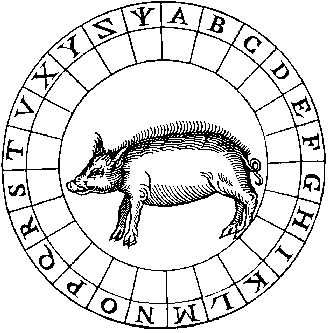動物裁判
Animal
Trial as
Mirror

解説*池田光穂
動物裁判
Animal
Trial as
Mirror

解説*池田光穂
ヨーロッパで広く行なわれた動物裁判は、人間に危害を加えたり、また人間と共同して罪を犯したと認定されたとき、人間とまったく同じ 法的手続きを通して(つまり完全に“擬人化”されて)世俗ないしは教会の 裁判所で裁かれたという。極端な例では、裁判所の書記が動物に対して 判決を読み上 げたり、動物を拷問してその叫び声を自白とした場合もあった(池上 1990)。
Animal trial (source: Wikipedia)
[A]n animal trial was the criminal trial of a non-human. Such trials are recorded as having taken place in Europe from the thirteenth century until the eighteenth.
Animals, including insects, faced
the possibility of criminal charges for several centuries across many
parts of Europe. The earliest extant record of an animal trial is the
execution of a pig in 1266 at Fontenay-aux-Roses.[1]
Cohen, Esther (1986),
"Law, Folklore and Animal Lore", Past and Present (Oxford University
Press) (110). ISSN 00312746, p.8
Such trials remained part of several legal systems until the 18th century. Animal defendants appeared before both church and secular courts, and the offences alleged against them ranged from murder to criminal damage. Human witnesses were often heard and in Ecclesiastical courts they were routinely provided with lawyers (this was not the case in secular courts, but for most of the period concerned, neither were human defendants). If convicted, it was usual for an animal to be executed, or exiled. However, in 1750, a female donkey was acquitted of charges of bestiality due to witnesses to the animal's virtue and good behaviour while her human co-accused were sentence to death.[2]
Srivastava, Anila.
(March 1, 2007) "Mean, dangerous, and uncontrollable beasts": Mediaeval
Animal Trials. Volume 40, issue 1, page 127. Mosaic: A Journal for the
Interdisciplinary Study of Literature.
Translations of several of the most detailed records can be found in E.P. Evans' The Criminal Prosecution and Capital Punishment of Animals, published in 1906. Sadakat Kadri's The Trial: Four Thousand Years of Courtroom Drama (Random House, 2006) contains another detailed examination of the subject. Kadri shows that the trials were part of a broader phenomenon that saw corpses and inanimate objects also face prosecution; and argues that an echo of such rituals survives in modern attitudes towards the punishment of children and the mentally ill.
Evans, E. P. (1987) [1906], The
Criminal Prosecution and Capital Punishment of Animals, Faber and
Faber. ISBN 978-0-571-14893-6
■動物裁判(池上俊一)・ノート
ヨーロッパで広く行なわれた動物裁判は、人間に危害を加えたり、また人間と共同して罪を犯したと認定されたとき、人間とまったく同じ 法的手続きを通して(つまり完全に“擬人化”されて)世俗ないしは教会の 裁判所で裁かれたという。極端な例では、裁判所の書記が動物に対して判決を読み上 げたり、動物を拷問してその叫び声を自白とした場合もあった。(池上 1990)
【時期と頻度】
ヨーロッパ、とくにフランスを中心にして「動物裁判は、萌芽的には12世紀、あるいはそれ以前からみられ、13世紀以降本格化のきざ しをみせ、14〜16世紀をピークとして、18世紀までつづく」(p.28)。その件数は、池上の推定だと大ざっぱに見積って数百件のオーダーになるとい う(pp.27-8の言及を根拠にした)。(池上 1990)
【裁かれた動物の種類】
豚、馬、ろば、牛、犬、猫、もぐら、など(池上 1990)
【嫌疑された罪】
殺人、畑や果樹園を荒した、獣姦の“共犯”、魔術にかかわる罪、“自然に反する罪”(特異な才能をもったり、異常な能力——雄鶏が卵 を産む)(池上 1990)
【動物以外に裁かれた対象】()内は処罰の内容
作物を台無しにした昆虫(破門)、鳴き声が騒々しいスズメ(破門)、殺人の嫌疑をかけられた森(伐採)、反乱者の集会に使われた鐘楼 の鐘(幽閉)(池上 1990)
【池上による解説】
中世の全時期からルネサンスにかけて、それ以前の自然と共存した生活形態から、種々の技術や発明を通してヨーロッパの社会が自然を征 服するようになった。「‥‥その時期に達して、自然世界とはべつの原理と構成をもつ文化世界があらわれ、さらにその原理を意識化し、それを根城として自然 を自らのシステムに奉仕させようという運動と思考が、緒についたのである。だからこの『征服』は、同時に自らとことなる外なるものを自らの内にとりこみ、 その原理に服させる『領有』であったといえる。」(p.148)「‥‥自然世界の領有が技術や機械による自然の人間世界へのとりこみであったように、動物 裁判は、人間の世界を律する法・訴訟手続を自然に適用して、自然を人間の理性や文化の条理に無理矢理おしこむ装置であったのだから。」(pp.148- 9)。「わたしたちは、動物裁判をヨーロッパ中世、より正確には12世紀以降における自然と文化の関係における未曾有の地殻変動のひとつのシンボリックな 表現であると考える」(p.149)(池上 1990)
こ の変化を池上は、キリスト教とそれ以前の異教的伝統の葛藤、自然の秩序から人間の秩序へ、自然の描写の様式の変化、人間中心主義の 確立、身体のメタファーの変化、法概念の変化、などから傍証してゆく(p.151-)。そして、動物裁判が与えてきた“前近代の非合理主義の残滓=ざん し、としてでななく、「当時あらゆる領域を席巻した『合理化運動』の落し子なのではないか」(p.207)という。(池上 1990)
コーエン(Cohen, Esther)の説(省略→pp.208-9)(池上 1990)
コメント
人間中心主義の観点からみると、動物裁判における動物の「擬人 化」は、ひとつのアイロニーとして理解することができる。コーエン説はこ のアイロニーをもってよりよく理解できそうだ。
リンク
文献
Copyleft, CC, Mitzub'ixi Quq Chi'j, 1996-2099
